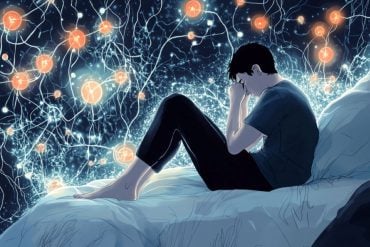Summary: Isoguavacine, an old experimental compound which exclusively targets peripheral neurons, mitigates abnormal touch sensitivity in mouse models of ASD. The compound also improved body mass, reduces anxiety, and in one genetic subset of mice, prevented the development of brain abnormalities that arise from altered touch response.
Source: Harvard
The inability to tolerate light touch is a telltale feature of autism and one of the disorder’s many perplexing symptoms. It has defied treatment, and its precise origins have remained somewhat of a mystery.
Now a study led by investigators at Harvard Medical School’s Blavatnik Institute has not only identified the molecular aberrations that give rise to heightened touch sensitivity in autism spectrum disorders but also points to a possible treatment for the condition.
The research, conducted in mice and published Aug. 8 in Cell, shows that an old experimental compound that exclusively targets the peripheral nerve cells not only mitigated abnormal touch sensitivity, but also improved body mass, alleviated anxiety and, in a subset of mice, prevented the development of certain brain abnormalities that arise from altered touch response.
If affirmed in further studies, the findings could help pave the way toward much-needed treatments, the research team said.
Current therapies, while somewhat effective, remain suboptimal because they cross the blood-brain barrier and cause sedation and memory problems.
“More and more people are diagnosed with autism and related disorders and the need to identify effective therapies with minimal or no side effects is acute. We believe our findings set the stage for the development of a new class of medicines that may not only treat sensory overreactivity but some of the other core behaviors seen in autism spectrum disorders,” said study senior investigator David Ginty, professor of neurobiology in the Blavatnik Institute at Harvard Medical School and a Howard Hughes Medical Institute investigator.
Additionally, the findings underscore just how important the peripheral nervous system is to brain development, the team said, providing a key clue into now-classic observations that young children deprived of normal touch during infancy have a greater risk of behavioral abnormalities in later life.
“Our findings help provide a molecular basis for a phenomenon that physicians and scientists have observed for decades,” said study first author Lauren Orefice, assistant professor of genetics in the Blavatnik Institute at Harvard Medical School and the Department of Molecular Biology at Massachusetts General Hospital. “Our results add to a growing body of evidence demonstrating that abnormalities in peripheral neurons can hamper the development of key areas of the brain in newborn animals and contribute to behavioral problems later in life.”
Earlier work by the same team identified defects in two specific genes–Mecp2 and Gabrb3–as the underlying drivers of abnormal touch sensitivity. Their absence in peripheral neurons, the work showed, decreases the activity of a key neurotransmitter, GABA, a chemical known to tamp down nerve signaling and regulate nerve-to-nerve communication in the spinal cord and brain. These findings also showed that low GABA-receptor activity in peripheral sensory neurons underlies aberrant neuronal signaling and overactive nerve-cell firing in the spinal cords of mice lacking Mecp2 or Gabrb3, thus leading to heightened touch sensitivity. Building on these findings, Ginty, Orefice and colleagues conducted a series of experiments demonstrating that each of these, as well as other genes linked to autism spectrum disorders, regulate distinct properties of peripheral neurons. When absent or defective, they give rise to altered sensitivity to light touch.
The new study additionally demonstrates that mice lacking yet another gene, Shank3, also had abnormal touch responses. However, the malfunction in neurons lacking Shank3 was different from the dysfunction seen in neurons lacking the other two genes, the study showed. Shank3-deficient neurons retained normal GABA signaling but had altered function in these cells’ potassium channels, which rendered them more excitable. Animals whose peripheral neurons lacked Shank3 also exhibited traits associated with autism, including anxiety and social impairment.
Next, the researchers examined the interplay between peripheral neuronal genes and the central nervous system. They turned their attention to key areas in the brain that receive and process touch signals from the peripheral nerves. The experiments revealed that animals lacking Mecp2, Gabrb3 and Shank3 genes only in their peripheral neurons had marked alterations in brain circuits that regulate and process touch sensation. Conversely, restoring the presence of these genes in the peripheral neurons improved circuit development and function in the brains of newborn mice and restored normal touch sensitivity–an observation that underscores the critical role that peripheral nerve activity plays in brain development, the researchers said.
Notably, the scientists observed that mice that showed the most serious alterations in brain development and exhibited the most serious symptoms were the animals in whom gene mutations had occurred early in development. The finding, the team said, highlights the critical importance of normal peripheral nerve function early in life to ensure proper brain development.
Given that alterations in Mecp2 and Gabrb3 genes cause abnormal touch sensitivity and impact brain development by modulating signaling by the neurotransmitter GABA, the researchers decided to test whether increasing GABA-receptor activity would reduce the aberrant neuronal firing and normalize touch sensitivity. Indeed, boosting GABA activity nearly normalized the animals’ response to touch.
One of the central challenges in treating touch hypersensitivity stems from the fact that current GABA-modulating drugs sometimes used to treat the condition cross the blood-brain barrier and cause sedation and, at times, cognitive problems. The researchers needed a way to precision-target peripheral nerves without affecting the brain.
They turned to isoguvacine, an experimental compound from the 1970s that activates GABA receptors but is believed to be incapable of permeating the blood-brain barrier.
“Years ago, we started thinking ‘Wouldn’t it be lovely to be able to harness the power of these GABA drugs but restrict their activity to peripheral nerves?” Ginty said.
They were able to do precisely that.
Indeed, a series of experiments showed that treatment with isoguvacine normalized touch sensitivity in animals with features of autism-spectrum disorders and even attenuated anxiety and abnormalities in certain social behaviors.

The results, the researchers said, could help set the stage for developing treatments that recapitulate the drug’s effects.
“What we would like to see happen is the development of a new class of compounds that are chemically altered to act selectively on peripheral nerves while sparing the brain,” Ginty said. “That’s the simple dream we’ve had, and our findings bring it just a bit closer within reach.”
Co-investigators included Jacqueline Mosko, Danielle Morency, Michael Wells, Aniqa Tasnim, Shawn Mozeika, Mengchen Ye, Anda Chirila, Alan Emanuel, Genelle Rankin, Ryann Fame, Maria Lehtinen and Guoping Feng.
Funding: David Ginty and Lauren Orefice’s research was supported by HHMI, a Goldenson Postdoctoral Fellowship, a SFARI Research Award from the Simons Foundation, the Blavatnik Biomedical Accelerator at Harvard University and QFASTR, and by NIH grants K99 NS101057 and R35 NS097344.
Relevant disclosures: Ginty and Orefice have patents pending for the use of peripherally restricted GABA-receptor drugs.
Source:
Harvard
Media Contacts:
Ekaterina Pesheva – Harvard
Image Source:
The image is credited to Harvard.
Original Research: Closed access
“Targeting Peripheral Somatosensory Neurons to Improve Tactile-Related Phenotypes in ASD Models”. Lauren L. Orefice et al.
Cell. doi:10.1016/j.cell.2019.07.024
Abstract
Targeting Peripheral Somatosensory Neurons to Improve Tactile-Related Phenotypes in ASD Models
Highlights
• Distinct pathophysiologies cause peripheral sensory neuron dysfunction in ASD models
• Peripheral somatosensory neuron dysfunction alters brain development and behavior
• A peripherally restricted GABA AR agonist, isoguvacine, reduces tactile sensitivity
• Chronic isoguvacine treatment improves a subset of ASD-related phenotypes in mice
Summary
Somatosensory over-reactivity is common among patients with autism spectrum disorders (ASDs) and is hypothesized to contribute to core ASD behaviors. However, effective treatments for sensory over-reactivity and ASDs are lacking. We found distinct somatosensory neuron pathophysiological mechanisms underlie tactile abnormalities in different ASD mouse models and contribute to some ASD-related behaviors. Developmental loss of ASD-associated genes Shank3 or Mecp2 in peripheral mechanosensory neurons leads to region-specific brain abnormalities, revealing links between developmental somatosensory over-reactivity and the genesis of aberrant behaviors. Moreover, acute treatment with a peripherally restricted GABA A receptor agonist that acts directly on mechanosensory neurons reduced tactile over-reactivity in six distinct ASD models. Chronic treatment of Mecp2 and Shank3 mutant mice improved body condition, some brain abnormalities, anxiety-like behaviors, and some social impairments but not memory impairments, motor deficits, or overgrooming. Our findings reveal a potential therapeutic strategy targeting peripheral mechanosensory neurons to treat tactile over-reactivity and select ASD-related behaviors.






